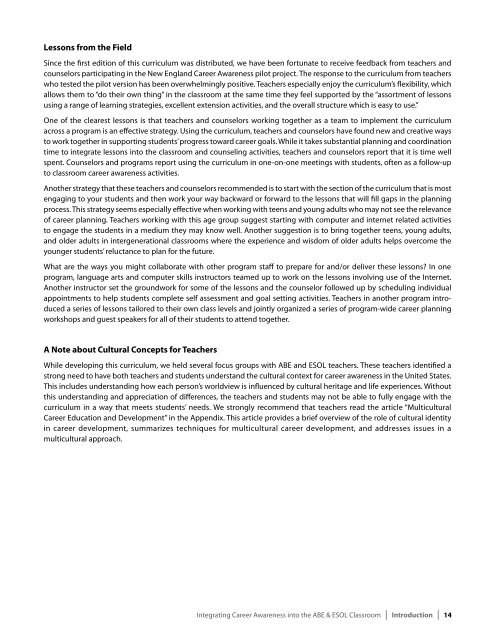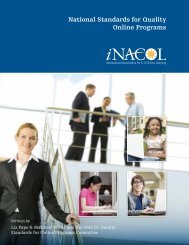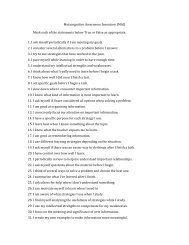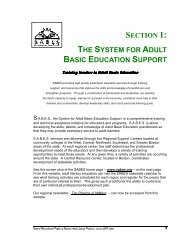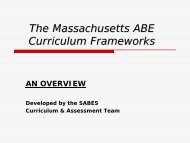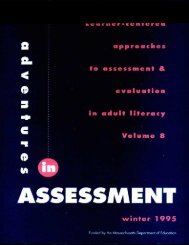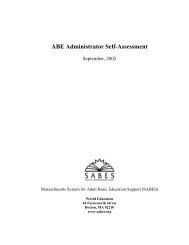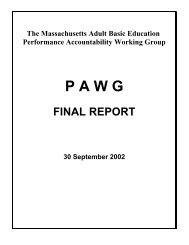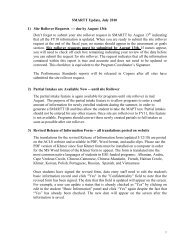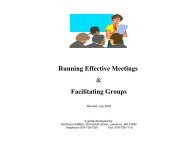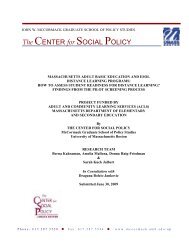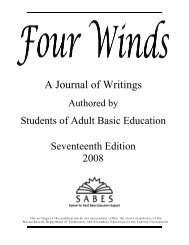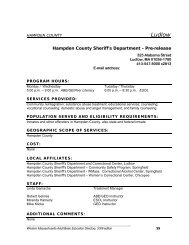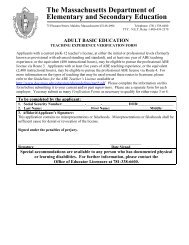Integrating Career Awareness into the ABE/ESOL Classroom - SABES
Integrating Career Awareness into the ABE/ESOL Classroom - SABES
Integrating Career Awareness into the ABE/ESOL Classroom - SABES
- No tags were found...
You also want an ePaper? Increase the reach of your titles
YUMPU automatically turns print PDFs into web optimized ePapers that Google loves.
Lessons from <strong>the</strong> Field<br />
Since <strong>the</strong> first edition of this curriculum was distributed, we have been fortunate to receive feedback from teachers and<br />
counselors participating in <strong>the</strong> New England <strong>Career</strong> <strong>Awareness</strong> pilot project. The response to <strong>the</strong> curriculum from teachers<br />
who tested <strong>the</strong> pilot version has been overwhelmingly positive. Teachers especially enjoy <strong>the</strong> curriculum’s flexibility, which<br />
allows <strong>the</strong>m to “do <strong>the</strong>ir own thing” in <strong>the</strong> classroom at <strong>the</strong> same time <strong>the</strong>y feel supported by <strong>the</strong> “assortment of lessons<br />
using a range of learning strategies, excellent extension activities, and <strong>the</strong> overall structure which is easy to use.”<br />
One of <strong>the</strong> clearest lessons is that teachers and counselors working toge<strong>the</strong>r as a team to implement <strong>the</strong> curriculum<br />
across a program is an effective strategy. Using <strong>the</strong> curriculum, teachers and counselors have found new and creative ways<br />
to work toge<strong>the</strong>r in supporting students’ progress toward career goals. While it takes substantial planning and coordination<br />
time to integrate lessons <strong>into</strong> <strong>the</strong> classroom and counseling activities, teachers and counselors report that it is time well<br />
spent. Counselors and programs report using <strong>the</strong> curriculum in one-on-one meetings with students, often as a follow-up<br />
to classroom career awareness activities.<br />
Ano<strong>the</strong>r strategy that <strong>the</strong>se teachers and counselors recommended is to start with <strong>the</strong> section of <strong>the</strong> curriculum that is most<br />
engaging to your students and <strong>the</strong>n work your way backward or forward to <strong>the</strong> lessons that will fill gaps in <strong>the</strong> planning<br />
process. This strategy seems especially effective when working with teens and young adults who may not see <strong>the</strong> relevance<br />
of career planning. Teachers working with this age group suggest starting with computer and internet related activities<br />
to engage <strong>the</strong> students in a medium <strong>the</strong>y may know well. Ano<strong>the</strong>r suggestion is to bring toge<strong>the</strong>r teens, young adults,<br />
and older adults in intergenerational classrooms where <strong>the</strong> experience and wisdom of older adults helps overcome <strong>the</strong><br />
younger students’ reluctance to plan for <strong>the</strong> future.<br />
What are <strong>the</strong> ways you might collaborate with o<strong>the</strong>r program staff to prepare for and/or deliver <strong>the</strong>se lessons? In one<br />
program, language arts and computer skills instructors teamed up to work on <strong>the</strong> lessons involving use of <strong>the</strong> Internet.<br />
Ano<strong>the</strong>r instructor set <strong>the</strong> groundwork for some of <strong>the</strong> lessons and <strong>the</strong> counselor followed up by scheduling individual<br />
appointments to help students complete self assessment and goal setting activities. Teachers in ano<strong>the</strong>r program introduced<br />
a series of lessons tailored to <strong>the</strong>ir own class levels and jointly organized a series of program-wide career planning<br />
workshops and guest speakers for all of <strong>the</strong>ir students to attend toge<strong>the</strong>r.<br />
A Note about Cultural Concepts for Teachers<br />
While developing this curriculum, we held several focus groups with <strong>ABE</strong> and <strong>ESOL</strong> teachers. These teachers identified a<br />
strong need to have both teachers and students understand <strong>the</strong> cultural context for career awareness in <strong>the</strong> United States.<br />
This includes understanding how each person’s worldview is influenced by cultural heritage and life experiences. Without<br />
this understanding and appreciation of differences, <strong>the</strong> teachers and students may not be able to fully engage with <strong>the</strong><br />
curriculum in a way that meets students’ needs. We strongly recommend that teachers read <strong>the</strong> article “Multicultural<br />
<strong>Career</strong> Education and Development” in <strong>the</strong> Appendix. This article provides a brief overview of <strong>the</strong> role of cultural identity<br />
in career development, summarizes techniques for multicultural career development, and addresses issues in a<br />
multicultural approach.<br />
<strong>Integrating</strong> <strong>Career</strong> <strong>Awareness</strong> <strong>into</strong> <strong>the</strong> <strong>ABE</strong> & <strong>ESOL</strong> <strong>Classroom</strong> | Introduction | 14


